“When Europeans first arrived, they thought the Aboriginal people were shipwrecked here. They couldn’t believe people survived with so few material possessions.”
Lori and I are hanging out with Chris Tobin, an Aboriginal elder and one of the NSW National Parks and Wildlife Service’s Aboriginal Discovery Rangers, at Blue Mountains Heritage Centre.
Within the first half an hour, he’s told us more about Australia’s indigenous culture than I’ve learned in my (nearly) 34 years of living in this country. We’re honoured to be welcomed to the Blue Mountains by a descendant of the original inhabitants of this land, and we’ve hung off his every word since the moment we met him.
Need to Know
Visitors looking for more walks, Aboriginal Discovery Tours, or information about Blue Mountains National Park, should check out the NSW National Parks and Wildlife Service online or contact them on 1300 072 757. Information on booking campsites is also available on the site.
Govetts Leap is located at the end of Govetts Leap Road in Blackheath. The lookout offers a picnic ground, toilets, and access to the cliff top walks and Fairfax Heritage Track.
The Emu Cave is just off the Bells Line of Road, near Mount Tomah. I don’t feel comfortable giving out directions here, but the site can be visited respectfully with an indigenous guide.
Blue Mountains Heritage Centre (Govetts Leap Road, Blackheath / open 9-4:30, 7 days a week, except for Christmas Day) features an interactive educational display, video screenings, an art gallery, and a shop selling maps, walking guides, books on the Blue Mountains and its natural and human history, souvenirs, clothing and gifts. Discovery Walks can be accessed from the centre throughout the year, but mainly during school holidays and weekends.
Spooners Lookout is right next to Echo Point Lookout, but would be very easy to miss. See here for a map.
When he demonstrates the two simple tools that the women in his culture would traditionally carry with them, and the insane number of different functions they could be utilised for, I can’t help but be saddened by how much we could have learned from their culture if we’d been more open to it.
By the time we leave the Heritage Centre for a tour of the area with Chris, he’s confirmed this thought even further, filling us in on how they view gender roles, raising children, and crime and punishment. Not only do I now know more about his culture now, but I have a different view of my own.
He touches briefly on the problems we’ve faced as a nation since Europeans first landed here, but his message is overwhelmingly positive. He tells us how some of his people believe that ‘spirit babies’ come down with the rain, and that they belong to the land they’re born to.
“It’s been documented that Europeans felt that Aboriginal people were the happiest they had ever met. No war, no competition. No arguing over land,” he says. “All my people believe different things, and that’s okay. Traditions were different in different tribes. All the ideals can work together.”
This chat with Chris gives me hope. He seems to think that Aboriginal Australia and the mishmash of other cultures that now share the land can live harmoniously together, in the same way the many clans of his people have for hundreds of thousands of years.
This attitude, obviously, extends to anyone who visits the Blue Mountains. “My people want to share this place with everyone. We just want people to respect it,” he says.
***
We park on the roadside and walk 100 metres or so up a gently ascending, unofficial but well-worn track, where we find ourselves at the entry to a sandstone cave. It’s about 6 metres wide at its mouth, and almost 10 metres deep. As we take a couple of steps inside, we notice that the walls are etched with hundreds of emu footprints.
“They’re not all emu prints,” Chris says. “There are some wallaby tracks there, and some that I think are lyrebirds too”.
He tells us that the story he’s heard about the cave is that a man offended the water spirits by drowning someone in a lake and they imprisoned him in the cave, where he marked the walls.
We crouch for a couple of minutes just taking in this special place, humbled by the ancient relic of a culture we’ve spent the morning engrossed in. We later find out that some of the etchings have been dated at 2,000 years old but, due to the inaccuracy of the dating process, they could have actually been there for anywhere up to 8,000 years.
Continuing up the spur, we bush-bash through thick low-lying scrub to a high point above Emu Cave; the summit of what was once known as Cave Hill. We’re afforded yet another stunning 360 degree panorama, but that’s not why we’re here. Soon we come to an opening in the vegetation, where we stand on a flat rocky outcrop, and Chris draws our attention down to a series of grooves in the rock.
“These are axe grinding grooves,” he tells us. “Now, let’s take a seat.”
Following his advice, we find ourselves sitting cross-legged in a circle around the grooves. Chris says nothing further, but watches us closely as the realisation simultaneously creeps across our faces that we’re sitting exactly where the local indigenous people have sat for thousands of years.
After a few minutes sitting in silent contemplation, Chris explains how they came about, due to Aboriginal people sharpening their stone axe heads. Recent rains have left a pool of water in the grooves. “This is how they would have been used,” he says, putting a finger into the water to trace one of them. “They would have filled the grooves with water to cool and clean the stone.”
We descend back to the car to spend a few more hours visiting other gorgeous Blue Mountains spots. We check out Govetts Leap, walk part of the Mount Banks Summit Track and Fairfax Heritage Track, and take in Anvil Rock and the Wind-Eroded Cave.
Our final stop with Chris is another special place for him; an Artist Camp he has setup where people gather to talk, do traditional dances, drink tea and coffee, have a fire, and paint on the trees using ochre paints. He tells us that they meet there once a week on a Saturday morning, and everyone is welcome no matter where they hail from, raving about a beautiful and elaborate tree-painting done by a hitchhiker from Denmark who he picked up one morning on the way to the camp.
Perched on logs in a patch of open dry woodland, we help Chris mix the paint, and then watch and listen intently as he paints concentric circles, explaining that they represent community and living together as a complete system. Later he paints a goanna, his totem in the traditional lore. He makes a fine paint brush from a twig, snapping it and fraying the end with his teeth, and uses it to draw the legs.
Handing us each a paint-brush, Chris tells us to go for it. I’ve never been much of a painter, so having loved the way Chris’s concentric circles looked on the trunk of these old Scribbly gum’s, I decide to just stick with the circles. Lori gets a bit more creative and incorporates some dots. Chris and I are equally impressed with what she comes up with.
When it’s time to go, I’m disappointed. It’s been an incredibly special experience. I wish I could come back on Saturday morning but we’ve got a hike planned, so I vow to return one day and hone my painting skills.
The Walks
Fairfax Heritage Track
This wheelchair and pram-accessible path runs from Blue Mountains Heritage Centre to Govetts Leap Carpark, winding through the diverse vegetation behind the cliffs of the Grose Valley near Blackheath. Nearing Govetts Leap, the forest opens up to views across Govetts Gorge, the Jungle, and Horseshoe Falls.
Length (km): 1.7 km (one way)
Time (hrs/min): 1 hour (one way)
Grade: Easy. Wheelchair accessible and suitable for prams.
Maps: No maps necessary. The track runs between the Blue Mountains Heritage Centre and Govetts Leap Lookout. There are no track junctions.
Return / Circuit / One-Way / Partial Circuit: Return or one-way.
Closest Town: Blackheath
Car Access: Blue Mountains Heritage Centre and Govetts Leap Lookout are on Govetts Leap Road Blackheath. This is accessed via the Great Western Highway.
Public Transport Access: Govetts Leap is a 3.1 km / 35 minute walk from Blackheath Train Station.
Anvil Rock & Wind-Eroded Cave
A short stroll leads to a lookout with views over the Grose Valley to Mount Banks and Mount Hay. The rocks look nothing like an anvil, but it’s actually named for one that was placed there for some reason in 1940. Returning to the carpark and heading west on another short track takes visitors to the Wind Eroded Cave, a massive rock-face that has been eroded by years of wind and rain, creating fantastic patterns in the sandstone.
Length (km): Anvil Rock: 500 m / Wind-Eroded Cave: 400 m
Time (hrs/min): 15 min
Grade: Easy.
Maps: No map necessary.
Return / Circuit / One-Way / Partial Circuit: Return
Closest Town: Blackheath
Car Access: From the Great Western Highway in Blackheath, turn East onto Hat Hill Road (near the train station, signed “Pulpit Rock”). Follow Hat Hill Road for about 2 km until it turns into a dirt road, then continue for a further 6 km. Follow the “Anvil Rock” signs to a car park.
Mount Banks Summit Walk
For a slightly more challenging walk, ascend the steep rocky track to the basalt cap summit of Mount Banks. Near the summit is a tall forest of Monkey gums, hilariously named by early explorers who, upon seeing the resident Greater gliders, thought they were actually monkeys.
Length (km): 2.4 km
Time (hrs/min): 4 hrs
Grade: Medium.
Maps: I’d recommend bringing a topographic map, but I’m unsure which maps cover this area. Ask at your local map shop.
Return / Circuit / One-Way / Partial Circuit: Return
Closest Town: Mount Tomah
Car Access: About 10 km west of Mount Tomah on the Bells Line of Road, take the turn-off signed “Mount Banks Picnic Area”. Head south for 1 km on an unsealed road and park at the Picnic Area. The walking track is signed “Mount Banks via ridge”.
***
With our cultural experience complete, Chris takes us to meet Sandy, the NSW National Parks and Wildlife’s Blue Mountains Discovery Coordinator, and we head to Echo Point in Katoomba. As usual the lookout is packed, but Sandy leads us down a track to the east that I’ve never noticed before. After a few minutes walk, we find ourselves the only people standing at Spooners Lookout. It might be the lack of people, but I think the view of the iconic Three Sisters from here is much nicer than at Echo Point.
Sandy tells us that Spooners has (relatively) recently been rebuilt, to improve the attraction for visitors. She also talks about the project that we can see is in progress, a 1.5 million dollar upgrade to The Three Sisters walking track. It’s not due for completion until at least April but, once finished, it will feature an upgraded surface, improved safety and access, and better visitor information. Having been constructed in the 1930’s, and now seeing around 2 million visitors a year, it’s a much needed upgrade. It might not be much of a true bushwalk, but I’ve never walked it myself so I’m keen to come back and give it a try.
There’s much more to Sandy than PR spiels, though. When Lori notices some white and purple Agapanthus across the gorge, Sandy’s knowledge and passion for the area starts to really shine. She tells us that although they’re non-native, they’re not considered to be noxious either, and that the RTA has only recently stopped using them as roadside vegetation in the Mountains. This leads to a discussion about the Dward Mountain Pine (Pherosphaera fitzgeraldii), a species with only 440 remaining examples in the Wild. It only grows under extremely specific conditions, in the spray of a south-facing waterfall at over 500 metres above sea-level. She tells us that abseilers often try to pull out as many non-native plants as they can, in order to give species like this one more of a chance.
We make our way to Cahill’s Lookout, the location of a bushfire in October 2014. Standing at the edge of Cliff Drive, the charred black expanse rolls away from us into the valley rolling out behind it. Many of the trees have begun to produce vibrant green offshoots and there are short green quills budding from the bases of the Grass trees. Bushfires occur semi-regularly here in summer, Sandy tells us. It’s obvious that the fires concern her. Aside from the occasional loss of lives and property, she’s worried that the fear of bushfires deters visitors in the warmer months. Sandy believes it’s very safe to visit the Mountains even during the bushfire season.
Over coffee, Sandy fills us in on some local European history and tells us the stories behind some of the major tourism businesses in the area. Eventually, I ask her if there’s anything in particular that she (and NPWS) want my readers to know. “Come and enjoy,” she says. “Some people seem to think we want to lock up this place and keep people out, but that’s not what we’re about.” She explains that their goal is to find the right balance between giving people the facilities they need to take advantage of this incredible slice of the Australian bush, and protecting it to make sure it can be enjoyed for years to come.
“Having people utilise the park is one of the best ways to protect it.”
Looking for the rest of the series? You can find all 5 posts in the series right here.
Eat
Housed in a converted auto-repair shop, Leura Garage Café & Restaurant (84 Railway Parade, Leura / Open 7 days, 12-5) is without a doubt my favourite eatery in the Blue Mountains. The staff are friendly and accommodating, and the food, sourced locally as much as possible, is absolutely to die for. We feast on tapas-style dishes like semi-dried tomato and parmesan arancini, a platter of roasted and smoked meats, sticky chicken wings, and grissini pizza dipped in olive oil and Leura Garage’s own pomegranate balsamic. Much to my excitement, Lori likes a beer these days, and we fall in love with one of their tap beers, the Badlands Pale Ale (brewed in Orange). We love it here so much that we can’t resist our final opportunity to try some different dishes, and return for a second night in a row.
Victory Café (17 Govetts Leap Rd, Blackheath / Open 7 days, 8-4) is our breakfast stop before a few of our days out hiking. They make a delicious coffee, and their yummy breakfast burger is the perfect fuel for a day in the bush. Once again, the staff are lovely and very accommodating, but this seems to be the trend almost everywhere in the Blue Mountains.
Blackheath Continental Deli (32 Govetts Leap Road, Blackheath) seems to be the go-to place for a packed lunch when hiking, so much so that they even have a roll on the menu called the “Bushwalker”. It’s a 10 out of 10 – would eat again.
Sleep
Our favourite accommodation during our week in the Blueys is Waldorf Leura Gardens B&B Resort (02 4784 4000 / 20-28 Fitzroy Street, Leura). Set on magnificent landscaped gardens, they even offer guided tours with their resident gardener (check with reception for dates and times). I take full advantage of the pool (probably why it’s the favourite), which the balcony of our spacious, modern room overlooks. There’s nothing like a swim after bushwalking on a summer day. We also enjoy a late night game of table-tennis and pool. The pool table is a little worse for wear, but I play so poorly that it makes no difference anyway. The resort has two restaurants but we only make it to one of them, for their excellent buffet breakfast.
Blackheath Motor Inn (02 4787 8788 / 281 Great Western Highway, Blackheath) has a rustic, mountain cottage feel but still feels new. Lori and I feel very cosy in our room, and love that we’ve got a back-door leading out to the garden and our own table and chairs. It’s also great being a short walk from The Gardners Inn, when we’re in need of a post-walk beer. The owners, Senga and Eddy, are a great source of local knowledge, especially for bushwalkers.
The Mountain Heritage Hotel & Spa Retreat (02 4782 2155 / Corner Apex & Lovel Street, Katoomba) sits on a hill overlooking Katoomba and some rooms, fortunately ours included, have views over the Jamison Valley. Despite hosting a wedding on the night of our stay, staff manage to make us feel like we’re their only guests.
Redleaf Resort (02 4787 8108 / Corner Evans Lookout and Valley View Roads, Blackheath) is perfectly located for hikers, just down the road from Evans Lookout, trailhead for the Grand Canyon Walk and the cliff-top track to Govetts Leap, among others. They have a games room, heated undercover pool, and playground.
During our stay in the Blue Mountains, we were guests of Blue Mountains Lithgow & Oberon Tourism, NPWS, Tread Lightly Eco-Tours, High & Wild Adventures, Scenic World, and Blue Mountains Guides. As is always the case, this has no influence over the opinions I present on Bushwalking Blog.
Have you checked out the Blue Mountains? Got any tips or tales to tell? Anything to add regarding Aboriginal culture and history? Please let us know by commenting below.




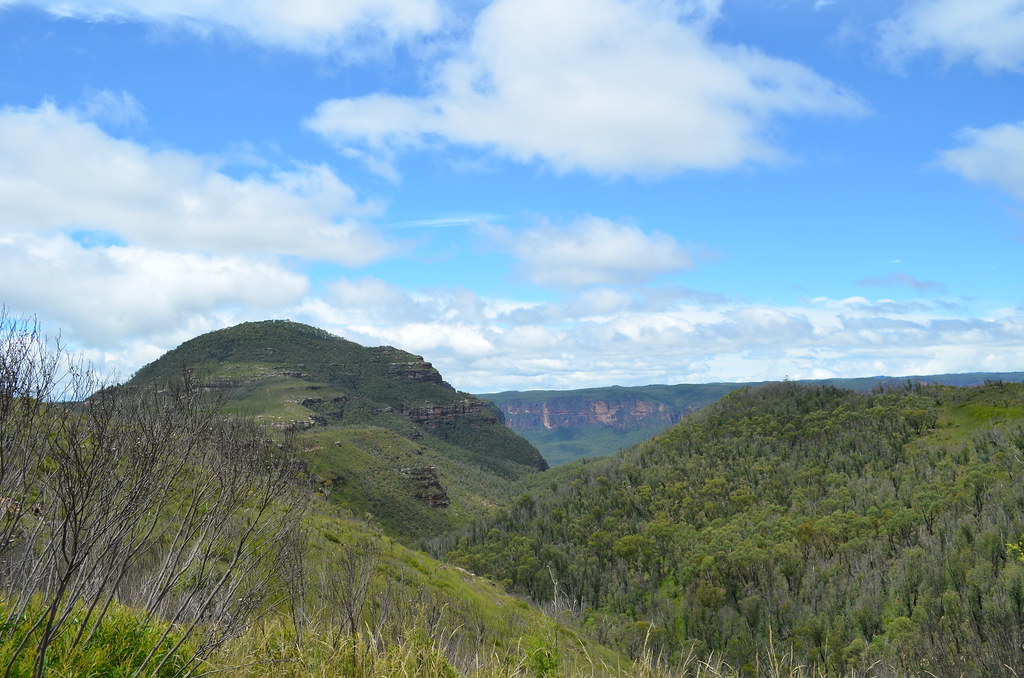
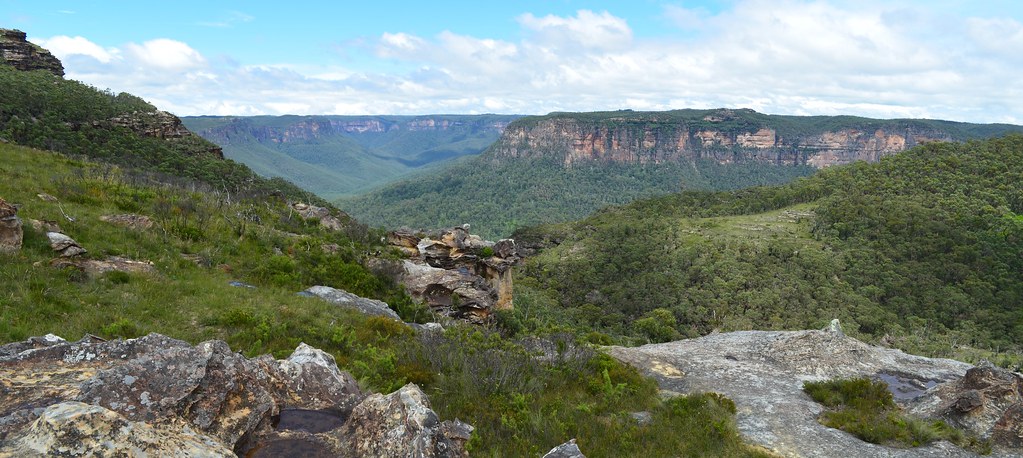
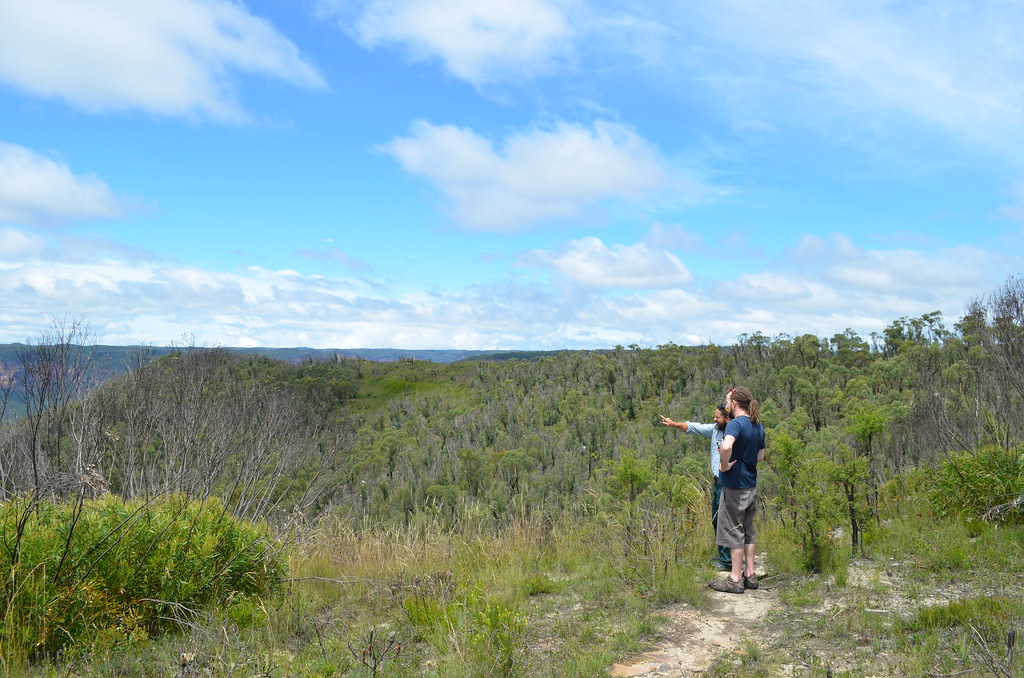

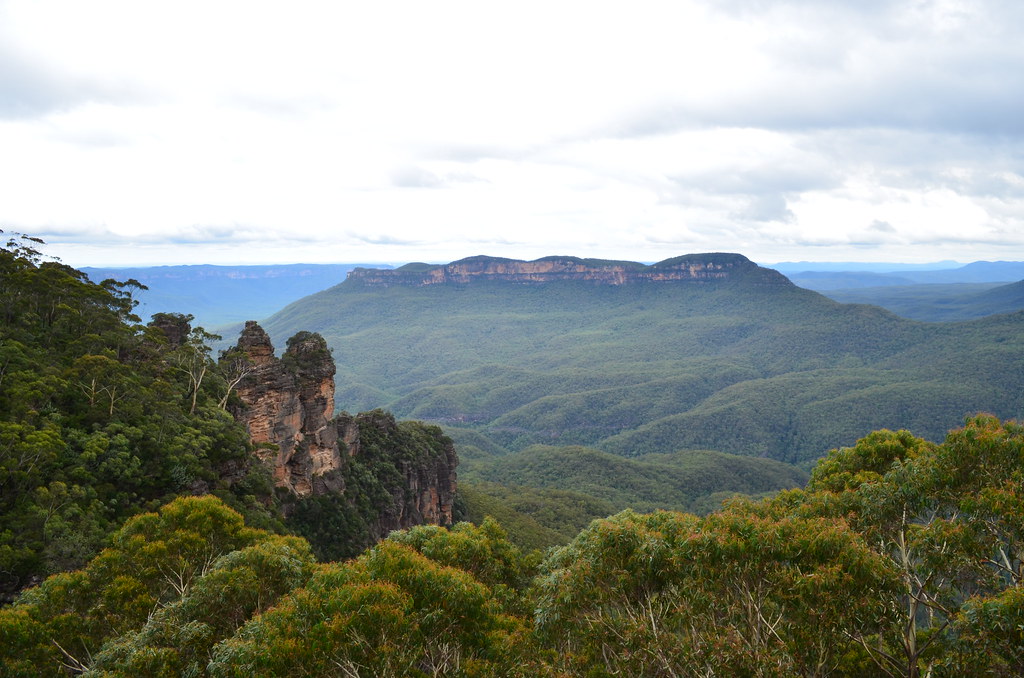
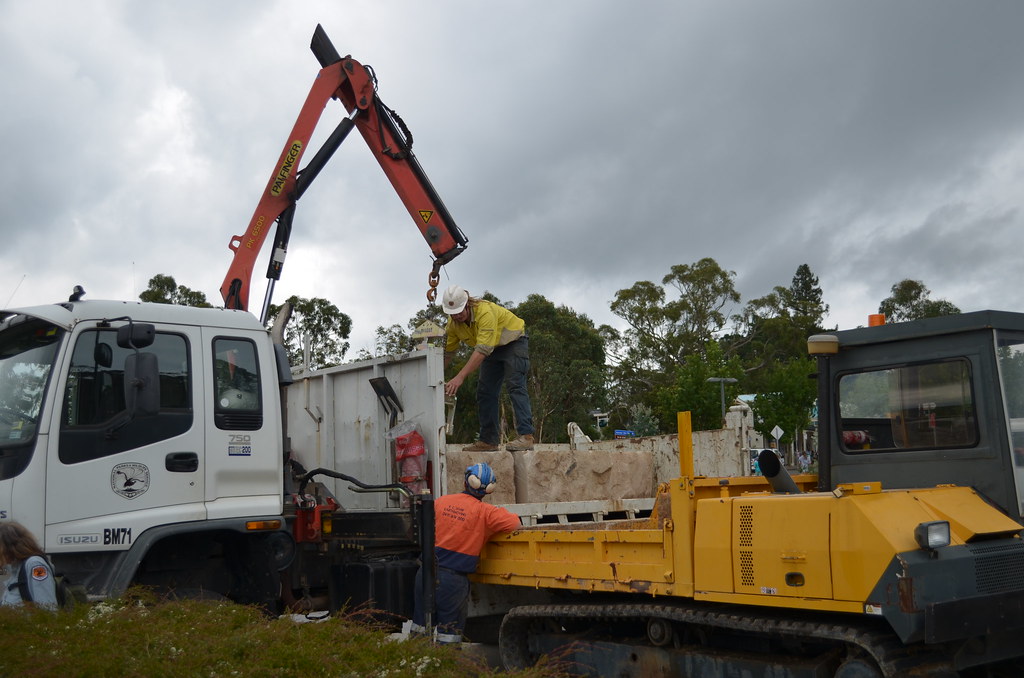
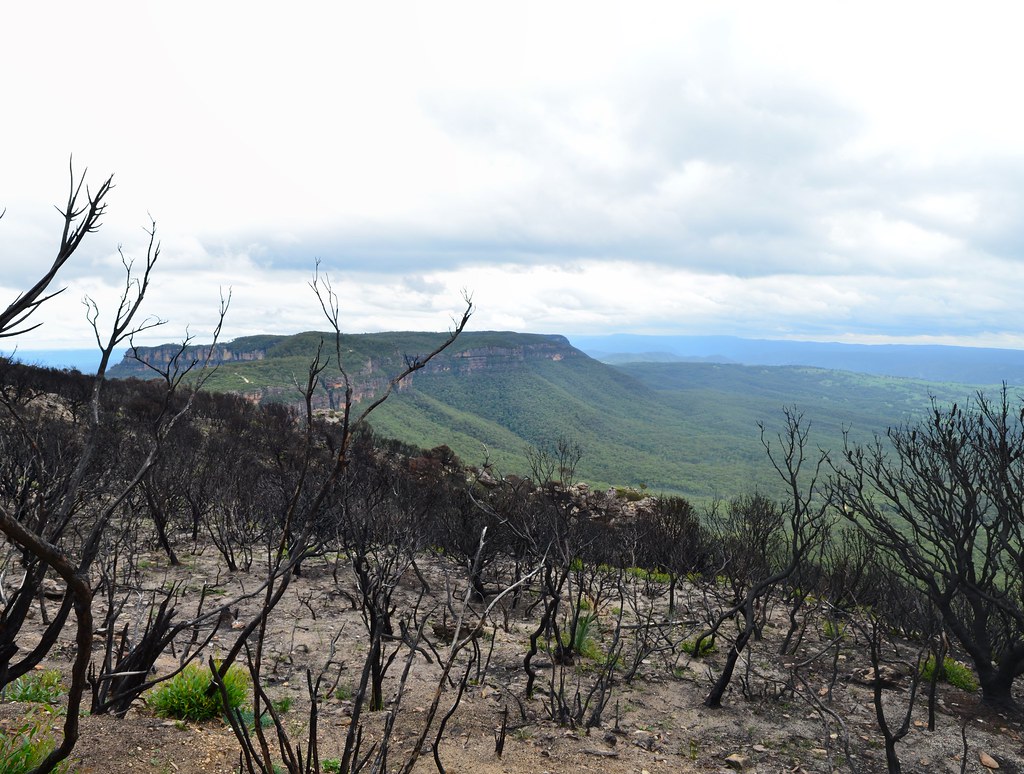




Woah fantastic post ! Adding locations to our bucket list quicker than ticking them off, which is fine by us 😀
Love the spiritual side you guys embraced throughout the blue mountains, really looking forward to following in the foot steps of both the traditional people and the bush walking blog! Keep up the awesome work guys.
Much love,
Will & Ashlee
Thanks guys! Haha the list never ends, does it?
We were just chatting about this trip and how much of a spiritual journey it was for both of us. Kinda life changing. We’re good hippy-types like that. 😉
Cheers for the comment
Neil
Hi Neil,
This post really makes me want to visit (and perhaps also live!) in the Blue Mountains area. I love that you shared the Aboriginal history. The more I write my own blog and have to research the places I visit the more I realize just how incredibly resourceful and knowledgeable the Indigenous Australians were. In just a short time we’ve caused so much damage to the environment.
Thanks for sharing this first installment of your trip. The photographs and descriptions are beautiful. It can be hard to come home after an experience like that. I can’t wait to get down that way and experience it for myself one day. 🙂
Hey Jane,
As I’ve mentioned to you, we’re toying with the idea of a move, so I get that completely. It’s a bit cooler there than where you are, too! 🙂
I’ve learned a bit about Aboriginal culture though researching blog posts in the past as well, but the thing that has stood out the most is how little information is available. I felt so privelaged to spend the day learning from Chris that I had to share as much as I could. I’m becoming a bit obsessed with the subject and the people now.
Thanks for the kind words about my post. 🙂 It was hard coming home, but was made a bit easier for me because I’m off to do Larapinta in 6 months (not that that’s very helpful to Lori). Hope you get to visit one day soon!
Cheers
Neil
Only made me mildly homesick, Neil. 😉 Looks like you got a wonderful tour around the mountains, and some nice food in, too! You visited a stack of my favourite old haunts. 🙂
Haha glad to hear it didn’t bite too hard, Jess! Probably helps being where you are though, I guess. 🙂
It was very awesome indeed… And that’s only the first day!
Cheers for the comment
Neil
There are just so many places in the Blue Mountains and most of them serve good food. For cheaper eats the Bakehouse On series of cafes are great, in Blackheath, Leura, Springwood and Glenbrook. The Fat Canyoners Good Grub Guide is very useful, if slightly out of date. If printing off then get the A4 version.
Hi Ken,
You’re right, we certainly didn’t eat any bad food during our stay. I’ll have to remember to check out that Bakehouse cafes and the Fat Canyoners Grub Guide before my next trip. Thanks for those!
Cheers
Neil
This is a great post Neil. I really like the way you wrote about the aboriginal history, particularly the part about how you were sitting around where the axes were sharpened and you had the realisation of the people who had sit in that place before you. Its very powerful to experience that feeling of such immense history, its an energy that seeps into your very being.
I like you often think of how different this country could have been if our ancestors had taken on board more of the culture of the countries original inhabitants.
I spent a week in the Blue Mountains a few years ago and fell in love with the place. I went to a few of the places you have mentioned and loved them all. How interesting was the wind eroded cave? The erosion was amazing. Great places and great post. I look forward to the next installment!
Thanks Amanda! Glad you enjoyed. 🙂 Next one coming very soon.
We totally fell in love with the place too. So much so that we’ve been talking about moving there ever since!
Cheers
Neil
Great stuff! looking forward to reading your next instalment.. my wife and I had a Christmas Day picnic near the wind eroded cave with glorious views down into the Grose Valley, we love living in the Blue Mountains!
PS: promise me you will let me know in advance of your impending visit to the area so we can catch up for a beer!
Thanks Michael. Nice one! It is a beautiful spot. Yep, will try and let you know!
Cheers
Neil